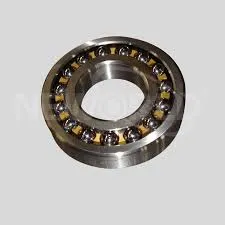
Dec . 01, 2024 02:55 Back to list
Understanding Spherical Roller Bearing Designation and Classification System for Effective Usage
Understanding Spherical Roller Bearing Nomenclature
Spherical roller bearings are a type of rolling-element bearing that can accommodate axial and radial loads in both directions. They are particularly known for their ability to handle misalignments and are widely used in applications such as wind turbines, construction machinery, and heavy industrial machinery. Gaining insight into their nomenclature is essential for engineers and technicians to effectively select, implement, and maintain these components in various operational environments.
Basic Structure of Spherical Roller Bearings
Before delving into the nomenclature, let’s briefly outline the basic structure of spherical roller bearings. These bearings consist of two rings (inner and outer), a set of spherical rolling elements, and a cage. The outer ring has a spherical raceway, allowing the rolling elements to realign themselves in the event of misalignment. This characteristic makes spherical roller bearings versatile and reliable, even in challenging conditions.
Nomenclature Breakdown
The nomenclature of spherical roller bearings provides crucial information regarding their dimensions, design, type, and specific features. It typically follows a set format determined by various standards, with the most common being set by the International Organization for Standardization (ISO) and the American National Standards Institute (ANSI).
1. Basic Designation The basic designation of a spherical roller bearing usually consists of a series of letters and numbers. For example, a common designation may look like “22215” where “222” indicates the bearing type (spherical roller bearing) and “15” indicates the bore diameter in millimeters.
2. Prefix and Suffix Codes Manufacturers often add prefixes and suffixes to the basic designation to provide additional information. For example, a ‘K’ might indicate a tapered bore, while ‘E’ typically signifies an extra capacity design. The suffixes also detail features such as special internal designs, lubrication options, or the presence of seals and shields.
spherical roller bearing nomenclature

3. Dimension Series Bearings are categorized into dimension series, which dictate the relationship between bore diameter, outer diameter, and width. This series helps engineers choose appropriate bearings that fit the space and load requirements of their applications.
4. Load Ratings and Specifications Alongside the basic designation, manufacturers typically provide dynamic and static load ratings, which indicate the bearing's ability to withstand forces while in motion or at rest. Understanding these ratings is critical for ensuring the longevity and reliability of the bearing in service.
5. Material and Coating Designations The materials used in the construction of spherical roller bearings are also denoted within its nomenclature. For instance, a specific suffix might indicate the use of corrosion-resistant materials or special heat treatment processes that enhance performance or lifespan.
Importance of Proper Nomenclature
Proper understanding of spherical roller bearing nomenclature is vital for multiple reasons. First, it ensures the correct bearing is selected for a particular application, preventing potential failures caused by mismatched specifications. Second, it aids in efficient inventory management, allowing for quick identification and replacement of bearings in maintenance scenarios. Finally, thorough grasp of nomenclature builds a foundation for effective communication among engineers, suppliers, and maintenance personnel.
Conclusion
In summary, the nomenclature of spherical roller bearings encapsulates a wealth of information critical for their application and performance. From basic designations to load ratings, understanding these components enables engineers and technicians to make informed decisions, ultimately leading to safer and more efficient machinery operations. As industries continue to rely on these robust components, a deeper knowledge of their nomenclature becomes not only beneficial but essential for sustainable operational success. Understanding these nuances will contribute significantly to the optimal performance and longevity of spherical roller bearings in various applications.
Latest news
-
Spherical Roller Bearings Applications: Heavy Duty, Self-Aligning
NewsAug.30,2025
-
Premium Deep Groove Ball Bearings | High Speed & Reliability
NewsAug.29,2025
-
Durable Scaffolding Clamps - Secure & Reliable Tube Connectors
NewsAug.28,2025
-
Common Failures in Thrust Ball Bearings and Solutions
NewsAug.22,2025
-
How Tapered Roller Bearings Can Take Shock Loads
NewsAug.22,2025
-
Angular Bearings in High-Precision Spindles
NewsAug.22,2025
